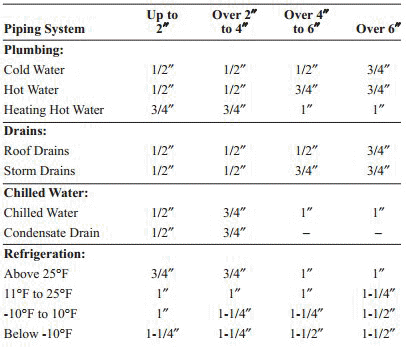 |
Satish Lele lelepiping@gmail.com |
View this page as YouTube Video Presentation
Specs for Piping:

- Install pipe insulation by slitting tubular sections and applying onto piping or tubing. Alternately, whenever possible, slide unslit sections over the open ends of piping or tubing. All seams and butt joints shall be adhered and sealed using adhesive.
- Insulation shall be pushed onto the pipe, never pulled. Stretching of insulation may result in open seams and joints.
- Tape the ends of the copper tubing before slipping the insulation over the new pipes to prevent dust from entering the pipe.
- All edges shall be clean cut. Rough or jagged edges of the insulation shall not be permitted. Proper tools such as sharp non-serrated knives must be used.
- On cold piping, insulation shall be adhered directly to the piping at the high end of the run using a two-inch strip of insulation material on the ID of the insulation and on the pipe. All exposed end cuts of the insulation shall be coated with Adhesive. All penetrations through the insulation and termination points must be adhered to the substrate to prevent condensation migration.
- Sheet insulation shall be used on all pipes larger than 150 mm NB. Insulation shall not be stretched around the pipe. On pipes larger than 300 mm NB, adhere insulation directly to the pipe on the lower 1/3 of the pipe. On pipes greater than 600 mm NB, complete adhesion is recommended.
- Seams shall be staggered when applying multiple layers of insulation.
- All fittings shall be insulated with the same insulation thickness as the adjacent piping. All seams and mitered joints shall be adhered with adhesive. Screwed fittings shall be sleeved and adhered with a minimum 25 mm overlap onto the adjacent insulation. Adhesive shall be used with insulation material.
- Valves, flanges, strainers, and Victaulic couplings shall be insulated using donuts that shall then be covered with sheet or oversized tubular insulation.
- Support piping system using high density inserts with sufficient compressive strength. The pipe support insulation shall be elastomeric foam with the same or greater thickness than the pipe insulation. All joints shall be sealed with adhesive.
- Standard and split hangers, Piping supported by ring hangers shall have hangers insulated with the same insulation thickness as the adjacent pipe. All seams and butt joints shall be sealed with adhesive. Ring hangers may be sleeved using oversized tubular insulation. On cold piping, insulation shall extend up the hanger rod a distance equal to four times the insulation thickness. Insulation tape may be used to a thickness equal to the adjacent insulation thickness.
- Clevis hangers or other pipe support systems, Saddles shall be installed under all insulated lines at unistrut clamps, clevis hangers, or locations where the insulation may be compressed due to the weight of the pipe. All piping shall have wooden dowels or blocks of a thickness equal to the insulation inserted and adhered to the insulation between the pipe and the saddle. It is highly recommended for continuous insulation protection to use hanger sizes equal to the outer diameter of the pipe plus insulation thickness.
- To minimize the movement, it is recommended that a pair of non-skid pads be adhered to the clamps. In addition, to prevent loosening of the clamps, use of an antivibratory fastener, such as a nylon-locking nut, is also recommended.
- All outdoor exposed piping shall be painted with two coats of paint Finish. Prior to applying the Finish, the insulation shall be wiped clean with denatured alcohol. The Finish shall not be tinted.
- All outdoor exposed piping shall have the seams located on the lower half of the pipe.

 to get all the information as a eBook
to get all the information as a eBook
